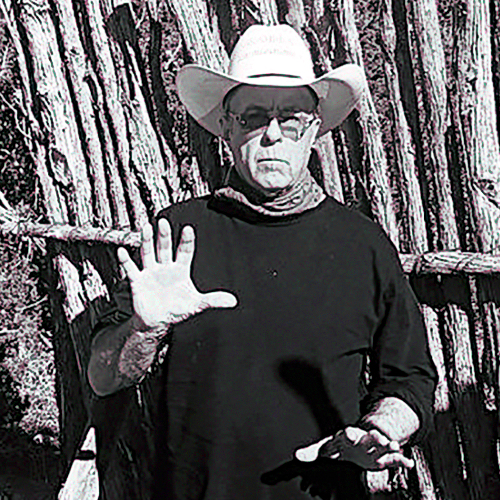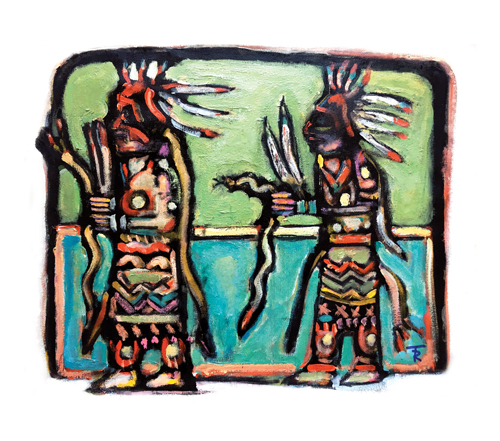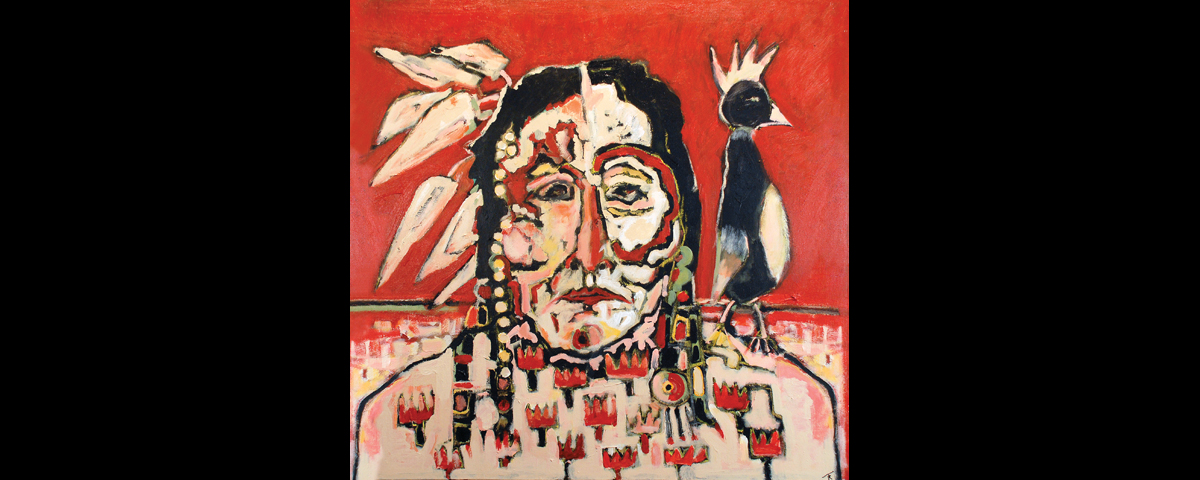
Most artists will tell you they knew from an early age they wanted to paint or sculpt. Tom Russell turned to the visual arts—the musical and lyrical arts are another story—far later in life on a whim. As he tells it, one day in 2003 while living in El Paso, Texas, he walked into his home studio, and the urge to paint struck. “I took out the easel and started painting a cow that looked like a dog. It wasn’t very good, but it was interesting.”
But then, Russell has always done things his way. These days the singer-songwriter, essayist, performer and painter of folk and fine art splits his time between homes in Austin, Texas, and Switzerland. The El Paso Museum of Art exhibits his paintings, as do galleries in Austin, Santa Fe (N.M.), Scottsdale (Ariz.) and Switzerland. He also has published two books of his art: Blue Horse, Red Desert (2011) and Folk Hotel: Reflections, Paintings, Lyrics (2017).
“I’m not native American,” he says, “but I find myself attracted to them. My first songs were about native Americans.” He has painted Hopi (Hopi Snake Dancers), Pima (The Long Memory of Billy White Horse) and northern Plains Indians (Ghost Dance and Gall). “I’ve done Gall a couple of times,” Russell says. “I found an interesting photo of Gall in which all his feathers are going off in one direction. It made an arresting image.”

Most people know Russell as another sort of artist. Among the songs he has written or co-written are “Gallo del Cielo,” “Veteran’s Day” and “Outbound Plane,” which have been covered by a who’s who of artists, including Johnny Cash, Guy Clark, Iris Dement, Ramblin’ Jack Elliott, Joe Ely, K.D. Lang, Nanci Griffith, Ian Tyson, the Texas Tornados and Jerry Jeff Walker. Western Writers of America voted two of Russell’s songs, “Navajo Rug” and “Tonight We Ride,” into its list of Top 100 Western Songs. His association with the music industry in turn has moved Russell to paint such noted singer-songwriters as Cash, Bob Dylan, Leonard Cohen and Gram Parsons.
“We have people come in who know who Tom is,” says Zac Cox of the iconic Santa Fe gallery and shop The Rainbow Man, “and they’re looking for his art, and they love it because they associate it with one of their favorite musicians. But a lot of the time people just walk in the door and fall in love with [Russell’s paintings]. So his art truly is folk art, where it hits everybody across the board. He’s a true American folk artist.”
When possible Russell spends up to three hours a day painting, at his wife’s insistence standing up to keep the blood flowing. “I can paint anywhere,” he says. “I paint in a small room in an apartment in Switzerland.” Something must be working, as his reputation as a visual artist keeps growing.
The artist’s first influence was his Los Angeles–based grandmother, Gladys Malloy, who worked as a painter when Russell was growing up in the early 1950s. “She never sold much, but she wasn’t interested in that,” he says.
“I grew up loving [Charles M.] Russell, [Frederic] Remington and Maynard Dixon,” Russell says, “but I see Western painting today in two or three categories: You have those who are really good at re-creating what it was like and is like, and then you have your expressionists, and you have your greeting card people—and there’s a place for that. I don’t paint to any category, but I respect it all.”
His other influences include Fritz Scholder and T.C. Cannon. “I like those guys because they’re colorists,” Russell explains. “I’ve really been influenced by Scholder. He’d put on Bob Dylan real loud and paint. I like to do that, too.” WW





